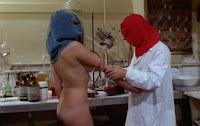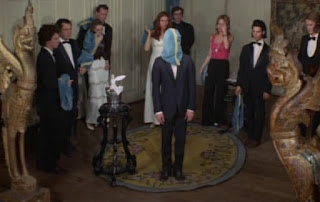Jean Rollin was a master at creating atmosphere – from Francoise Pascal’s dream to murder in
The Iron Rose (1973) and the escape of the schoolgirl clowns in
Requiem for a Vampire (1971), he put his, mostly female, leads through some very odd encounters and years on from viewing, that visceral feeling endures.
Of course, sometimes budget sometimes gets in the way of ambition and this is in evidence right from the opening moments of this film when people gather in laboratory wearing strange masks that somehow fail to menace… But, he was still learning his trade when this was made and, a certain rawness aside; it achieves much of what the above films do.
 |
| Strange shadows |
La Vampire Nue (English translation rather clumsily
The Nude Vampire) was written and produced by Rollin in 1970, his second film and his first in colour. It shows traces of the 1963 Georges Franju demi-classic
Judex, itself influenced by the genre-defining silent serial from Louis Feuillade in 1914, secret societies, animal masks, mysteries that just roll along from episode to unexplained episode. There’s an improvisational feel and a sense of an unwinnable battle – just what you need to propel an ongoing serial.
  |
| NHS cuts really take hold as Trust runs out of gowns... |
Here Rollin has an end on mind and is adding his own surreal touches to make a mood piece that comes close but never matches his better works. But it is unique and sometimes baffling cinema – the question of the “vampire’s” nudity being the least of the issues. There is splendid use of location from an eerie night chase through urban walkways to a huge stately home – oppressive exterior and interior - and finally to the director’s favourite beach (a frequent destination for family holidays and as seen also in
The Iron Rose).
 |
| Caroline Cartier |
It all adds up to a disturbance especially once the director has thrown in a quota of strangely subdued violence – the impact of bullets and bodies never seems entirely real – and, of course, female sexual presence: erotic dancing, an artist’s model who seems far too mobile to be painted, the barely-clothed Castel twins and the titular vampire – the stunningly well-proportioned Caroline Cartier. The members of the cult wear masks to avoid being seen by this vampire and yet she is revealed to the full for the audiences’ gaze: surely Jean was trying to tell us something?
 |
| Essential to the plot... |
The film starts with that weird blood test as a naked woman is examined by hooded medics. She is then seen escaping from the complex and is pursued by men in animal masks through shadowy streets. During the chase she encounters a young man Pierre (Olivier Rollin – the director’s step-brother) and takes an instant fancy… The two run but are trapped on a railway bridge, the woman faints and is carried away whilst Pierre climbs to freedom.
 |
| Pierre meets the Woman |
He follows the men as they carry the woman to a gated house where smart-suited guests start to arrive – he steals a ticket to gain entry. Once inside he witnesses the strangest kind of party… the elegant guests playing collective Russian roulette with the “winner” gladly shooting themselves. As they lie still warm, the woman descends the stairs to feast on their blood: the naked vampire discretely swathed in a gossamer wrap…
 |
| Party fears too... |
Pierre is the next lucky winner and he chooses a different path, shooting the compare and making good his escape…
Cut to a nightclub in which three middle aged men watch an aggressive erotic dance from Ly Lestrong. The eldest, Voringe (Bernard Musson) looks nervous , the tallest, Fredor (Jean Aron) leers awkwardly whilst the man ion the centre, Georges Radamante (Maurice Lemaitre) enjoys every second without restraint.
  |
| Nightcubbing... |
We next see Pierre in his flat where he is being aided by the weird sisters Castel (Marie-Pierre who was also in
Requiem and Catherine) who endure all kinds of wardrobe discomfort for Rollin’s art… It turns out that Pierre’s father is the gleeful ogler and that he’s heavily involved in the strange cult of the nude vampire.
 |
| Catherine Castel, Olivier Rollin and Marie-Pierre Castel (I think...) |
Pierre wants answers and enlists his pal Robert (Pascal Fardoulis) – the painter of the over-excited model – to search the premises of an office block owned by Georges. They find pictures of the woman and rooms full of researchers and then it’s hoods on as the nude vampire is escorted along a corridor… She recognises Pierre and all heck breaks loose as the boys are caught red-hooded!
  |
| Lucky dip? |
Pierre is interviewed by his father who assures him that all will be revealed and that things are – clearly – not quite as they seem…
 |
| Pierre cofronts Georges |
Now the action shifts up a gear as the men head off to a secret base – I love secret bases! – in a chateau whilst Georges’ right-hand woman, Solange (the elegant Ursule Pauly) disposes of Robert and we know that the society is playing winner takes all.
 |
| Ursule Pauly is Solange |
Pierre follows and encounters the Grandmaster (Michel Delahaye) a figure who seems to know what’s really going on… really!
Georges’ society believes that the woman is a vampire and that she can lead them to the secret of immortality but she may be something more and far from alone.
 |
| The Grandmaster confronts the Society... |
As the rich men huddle in their country retreat the Grandmaster’s forces gather to attack and rescue the woman. Pierre is stuck in the middle as true loyalties are revealed and the startling actuality emerges from behind a curtain on a distant beach…
 |
| The attack |
Dusty verdict: La Vampire Nue is absorbing in spite of the occasional clunky moment. The performances are very committed with Delahaye, Lemaitre and Ursule Pauly being especially impressive.
 |
| Topless terror! |
It benefits greatly from an unsettling soundtrack from Yvon Gerault, which grinds along impressively with the action: reflecting the alienation, displacement and fear of the characters… whilst cinematographer Jean-Jacques Renon helping Rollin realise those intense atmospherics.
 |
| Open the box... |
The story is slightly ahead of itself and, as if in recognition, Rollin has Radamante’s two colleagues walking away at the end neatly summarising what has gone before and the outstanding plot questions. Truth is, the plot was always secondary for Rollin and what he wants more than anything is for the film to engage his audience: to make us feel different.
La Vampire Nue is available on
Blu-ray and
DVD from Amazon.






























































